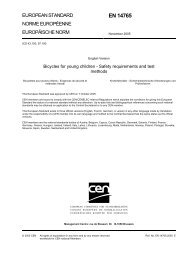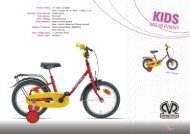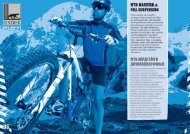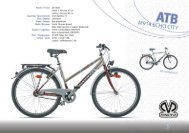EN 14766:2005 - 64_e_stf - Baltik vairas
EN 14766:2005 - 64_e_stf - Baltik vairas
EN 14766:2005 - 64_e_stf - Baltik vairas
- No tags were found...
You also want an ePaper? Increase the reach of your titles
YUMPU automatically turns print PDFs into web optimized ePapers that Google loves.
<strong>EN</strong> <strong>14766</strong>:<strong>2005</strong> (E)adjust wheel alignment and, if necessary, inflate tyres to the recommended pressure as marked on the side-wall ofthe tyre. Check and correct, if necessary, transmission-chain adjustment, and check any gear-control fitted forcorrect and free operation.Carefully adjust the saddle and handlebar positions to suit the rider.With a rider of appropriate size, ensure that the bicycle is ridden for at least 1 km.During the test, the bicycle shall be ridden five times over a course, 30 m in length, consisting of wooden stripsmeasuring 50 mm wide and 25 mm high with a 12 mm chamfer on the corners contacting the tyres. The strips shallbe spaced every 2 m over the 30 m course. The bicycle shall be ridden over this course at a speed of 25 Km/h.5 Manufacturer’s instructionsEach bicycle shall be provided with a set of instructions in the language of the country to which the bicycle will besupplied, containing information on:a) the type of use for which the bicycle has been designed (i.e. the type of terrain for which it is suitable) witha warning about the hazards of incorrect use;b) preparation for riding – how to measure and adjust the saddle height to suit the rider with an explanation ofthe insertion-depth warning marks on the seat-pillar and handlebar-stem. Clear information on which leveroperates the front brake, which lever operates the rear brake, and the presence of any brake-powermodulators with an explanation of their function and adjustment;c) indication of minimum saddle height and the way to measure it;d) the recommended method for adjusting any adjustable suspension system fitted;e) recommendations for safe riding – use of a bicycle helmet, regular checks on brakes, tyres, steering, rims,and caution concerning possible increased braking distances in wet weather;f) the permissible total weight of the rider plus luggage and the maximum total weight(bicycle+rider+luggage);g) an advisory note to draw attention to the rider concerning possible national legal requirements when thebicycle is to be ridden on public roads (e.g. lighting and reflectors);h) recommended tightening of fasteners related to the handlebar, handlebar-stem, saddle, seat-pillar, andwheels, with torque values for threaded fasteners;i) the method for determining the correct adjustment of quick-release devices, such as "the mechanismshould emboss the fork-ends when closed to the locked position";j) the correct method of assembling any parts supplied unassembled;k) lubrication – where and how often to lubricate, and the recommended lubricants;l) the correct chain tension and how to adjust it (if appropriate);m) adjustments of gears and their operation;n) adjustment of brakes and recommendations for the replacement of the friction components;o) recommendations on general maintenance;p) the importance of using only genuine replacement parts for safety-critical components;q) care of the wheel-rims and a clear explanation of any danger of rim-wear (see also 4.11.3 and 6.1);81







